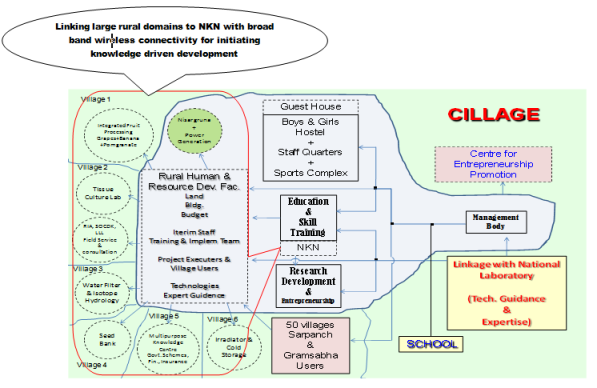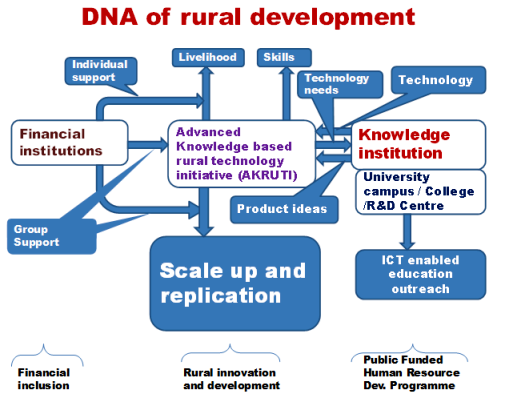
|
SCIENCE-BASED DEVELOPMENT
|
RELATED ARTICLES
|
|
|
Harnessing Science and Technology for Development: A Governance Challenge in Indian Context
There are several components to India growth story. Some are dependent on our demography, size of youth/work force, market potential, growing aspirations and factors like that. The others are driven by the increasing role of knowledge and technologies in economic activities. With the highly competitive world, that we live in, becoming increasingly knowledge dependent, the balance of trade is strongly dependent on our ability to leverage knowledge to value add or even better, to create new technological products that have competitive market appeal both in India and abroad. Thus, our ability to leverage S&T to create innovative products & processes and to nurture a right innovation ecosystem to translate them to the market place assumes greater importance now than any time before. Creating and nurturing people capable of doing so in large numbers and empowering institutions that host them to deliver on this count are the two most important governance challenges in contemporary India
DNA of rural development
A large part of our population lives in rural areas. These areas provide food for all of us. Disparity in terms of livelihood opportunities and amenities between urban and rural areas, is leading to a large scale migration to urban areas, a phenomenon that appears inevitable. There is however a fairly large and untapped potential for enhanced livelihood in rural areas. Realising this potential should not only lead to improved conditions for better and more attractive quality of life for majority of our citizens who live in rural areas and give impetus to higher food production but also reduce strain on the urban infrastructure which is unlikely to keep pace with the growing needs.
We need to pay greater attention to rural areas for yet another reason. We are fast embracing an innovation and technology driven interconnected world. We need to prepare our people, particularly the youth to effectively benefit from and contribute to the emerging globalised and knowledge based economy. Rural areas require much greater attention and speedier actions in this respect to ensure that most of our population is on the right side of the digital and hence economic divide. We therefore need to pursue a synergistic approach to education and development that is ICT enabled. I have been feeling for some time that an eco-system comprising of; 1) livelihood promotion framework that enables and empowers grass root people through knowledge, skill (both hard and sort) and technology inputs along with financial inclusion as well as backward and forward integration of their activities; and 2) education and training activities in rural areas that are focussed on the resources of the region and are integrated across different layers like advanced knowledge activities involving progressive structured expansion of knowledge envelope, exposure to procedural knowledge as well as related training and hands on skills capability through structured training and apprenticeship; is something that we should aim at as an integrated model of education and development. Some beginning has been made towards development of elements of such an eco-system. # Advanced Knowledge based Rural Technology Initiative (AKRUTI) centres have been established by BARC in association with Rajeev Gandhi Science & Technology Commission, Maharashtra and other agencies at around a dozen places around the country. These centres owned and run by local NGOs are linked to knowledge institutions (BARC and such others) to access relevant technology ideas and become demonstration centres for livelihood creation based on innovative implementation of these and other ideas. A key aspect of working of these Akruti centres relates to their becoming financially self sustainable after an initial one time support. Some of the earlier centres have reached that stage. # A model of engagement of higher education and research domain with the neighbourhood, in a rural setting, being developed in BARC is shown in the figure below. (Cillage - An eco-system that incorporates the best of a city and a village - a model for development for rural India) A Cillage would be linked to several Akruti centres in the neighbourhood and support them for their knowledge, technology, and human resource development needs. Such an infrastructure creates opportunities for students to study in an ambiance of real life activity based learning that is holistic and moulds research on the campus to be more focused to solving of problems before the society. Neighbourhood benefiting from the research, development and demonstration activities of the campus is an added advantage. Such a campus should be self sufficient in terms of facilities for education, research, development and  society outreach activities on one side and urban amenities including school education, medical, sports and entertainment facilities with employment/ work opportunities for spouses on the other. It is important that through such and other possibilities, we create attractions for competent youth to find sufficiently attractive career and entrepreneurship opportunities as well as a highly satisfying way of life in rural India. Synergistic working between such knowledge domains in which there are continuous attempts to push the relevant knowledge frontiers by best and motivated brains and the neighbourhood working to embrace new technological ideas should accelerate rural development as well as help retard migration to urban areas. New campuses in rural areas should pursue such a model. Presence of National Knowledge Network at Cillage could also be leveraged for ICT enabled transformation in primary education as well as other aspects of development in the neighbourhood up to 20-25 kM around using broad band wireless connectivity. A pilot project to demonstrate this approach is on the anvil. Such an eco-system would facilitate following key aspects of human resource and societal development:
Financial inclusion of people at the grass roots would be an essential factor for sustainable propagation of such model. This inclusion apart from creating individual identity (which micro-financed self help group creates), should also create a strong group identity (which co-operatives, collectives, federations etc. create). Such an approach should facilitate an effective and healthy linkage between target beneficiaries on one side and financial institutions and governmental agencies on the other. A schematic representation of such a development model is given below. Such frameworks could also be tasked to contribute to planning of local area development and oversee its implementation for and on behalf of local self governments.  |
IMPORTANT LINKS
|
|
